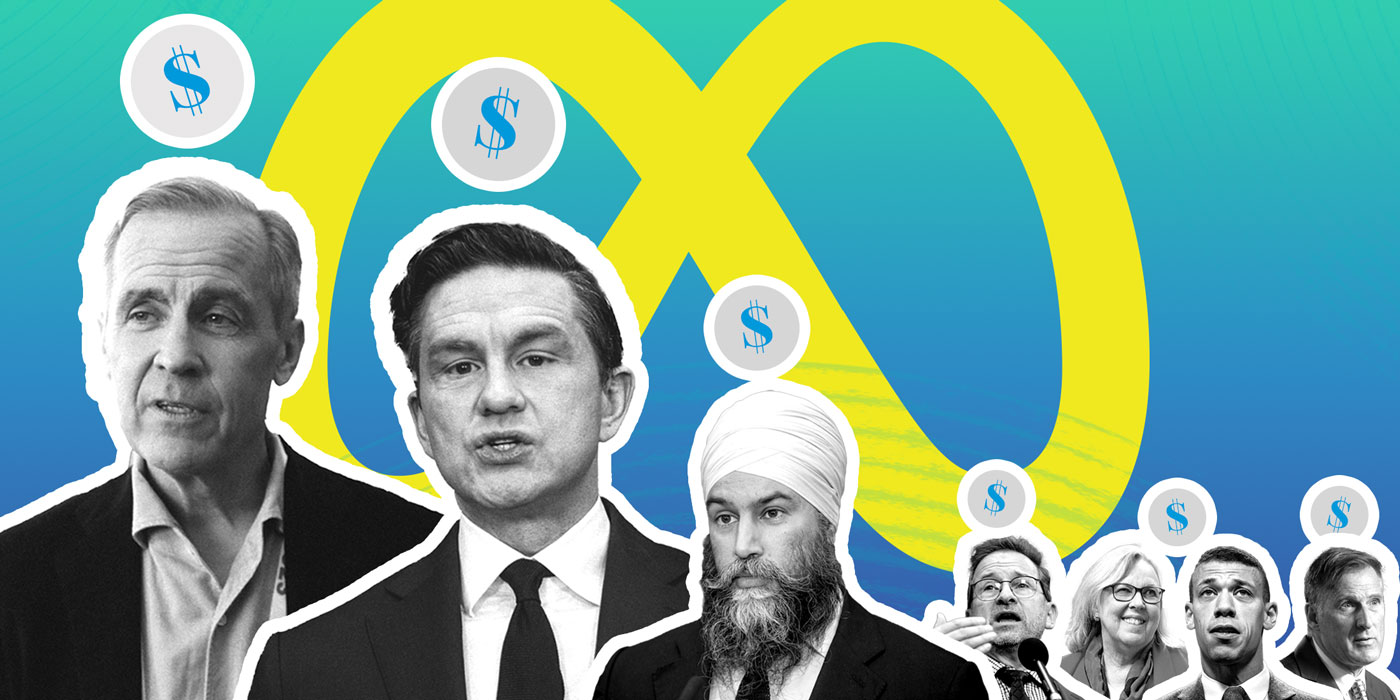Conservatives spent campaign ‘fending off attacks on all sides’ as Liberals, third parties dominated Meta election ads, says expert

Messaging from the Liberals and progressive third parties dominated Canadians’ Facebook and Instagram feeds this election, with the Grits, their leader and candidates, and left-wing special interest groups outspending the Conservatives by significant margins, as the previously dominant Tories fell further behind in the final week of the campaign.
Yet, while the Liberal Party and Prime Minister Mark Carney have gotten “nearly everything right” online this election, the decreased spending on Meta ads by Conservative Party and Leader Pierre Poilievre only tells part of the story, according to digital marketing expert Harneet Singh.
“As more and more seniors and boomers walk away [from the party], the Conservatives’ path to victory was through the youth vote, and they’re not on Facebook,” explained Singh, a managing principal at EOK Consults.
In the first 30 days of the 45th general election campaign—March 23 through April 19—the pages of prominent federal parties and leaders spent a combined $5.5-million on Facebook and Instagram advertising, according to Meta’s Ad Library, and are projected to spend nearly $8-million during the entire 37-day writ period.
The Liberals remained nearly $1-million ahead of the Conservatives entering the final week of the campaign, with a combined $3.058-million across both Carney’s and the party’s official Facebook and Instagram accounts, compared to the $2.23-million across the Conservatives’ and Poilievre’s pages. Much further back, the New Democrats and Leader Jagmeet Singh spent just over $104,264, followed by the Bloc Québécois with $93,758, and the Greens with $72,330.
Despite outspending all other parties combined nearly week-to-week since last September, the Conservatives have trailed the Liberals on Meta since the election began on March 23, when the Grits outspent the opposition Conservatives by 14-to-one: $118,922 versus $8,354.
While the Tories were quick to play catch-up—dropping more than $100,000 on March 25 and ramping that up to a roughly $120,000 daily spend over the next four days—the Liberals have been spending consistently higher on average—$103,233 per day versus $75,924.
When adding up the spending on Meta ads that includes pre-writ period of March 16-22, when the Conservatives paid $536,360 on Meta ads before the implementation of election spending limits
The Conservatives spent a total of $2.67-million on Meta ads during the four weeks of the campaign up to April 19—a figure which also includes the pre-writ spending of $536,360 from March 16-22, before the implementation of election spending limits. In comparison, despite spending less than half of what the Tories’ did during the pre-writ period—$250,400—the Liberals’ total for the same period is just shy of $2.96-million.

In an April 24 interview, Harneet Singh explained that the Liberals’ early focus on Carney’s “brand recognition,” spending substantial amounts on both pages each day, and the depth of not only content, but also its “expanded multilingual strategy” had allowed the party to quickly catch up to the Conservatives before surpassing them on the platform.
Singh noted that in early January, Carney’s Facebook page had up to 3,000 followers, before rising to 95,000 in early March, and has since jumped to more than 334,000.
The Liberals had been expanding their content and increasing the number of languages into which those ads were translated—including Mandarin and Punjabi—to match the Conservatives’ efforts. In the final days of the campaign, the Liberals pulled nearly all of their previous ads to focus entirely on Get Out The Vote campaigns.
The incumbent governing party also significantly increased their spending, breaching a $200,000 daily spend on April 23. The Liberals splashed out more than half a million dollars on Meta ads from April 22-24. In comparison, the Conservatives spent $394,629 in the same three-day period and had its first daily spend over $200,000 the next day, according to the most recent publicly available data as of April 28.
However, while Meta may no longer be where the Conservative Party is spending its advertising dollars, “to dismiss their digital game would be unfair,” Singh said.
While Meta is the only platform that publicizes near-up-to-date spending numbers for this election period, the Conservatives have continued to spend large amounts on radio and television advertising, including through connected Smart TV ads, as well as elsewhere online, Singh noted.
The Conservatives have also continued with the extensive third-language translations on almost all of those platforms, Singh said, recalling that during his commute in Toronto the previous week, “every third ad was a Conservative candidate or the Conservative Party on an ethnic radio station.”
While detailed expenses will not be available until the financial disclosures are released on Dec. 28, the parties are on track to spend more than one-third of the $18.5-million they collectively spent on digital online advertising during the 2021 election on Meta ads alone this year. During the last election, the Conservatives spent $5.7-million on online advertising, as well as $8.9-million on television ads, and a total of $17.7-million across all advertising platforms, including print, radio, and other mediums.
In 2021, the NDP narrowly outspent the Liberals in nearly every advertising category, including online, with the NDP spending $5.86-million compared to the Grits’ $5.72-million. The NDP paid $7.7-million for TV ads, compared to the Liberals’ $6.1-million. Overall, during the last election the NDP spent a total of $16.6-million on ads versus $16.2-million spent by the Liberals. The only category where the Liberals exceeded the New Democrats’ ad spending was in print, at $126,472 compared to $113,263, respectively.
In total, the Liberals, Conservatives, NDP, Bloc, and Greens spent nearly $52.6-million across all forms of advertising in 2021, and a collective $82.9-million across all categories of expenses.
During that election, the expense limits for the Liberals, Conservatives, and NDP were set at just over $30-million. Of that, the Liberals spent a little more than $27-million, the Conservatives spent just over $28.3-million, and the NDP spent $24.1-million.
During this election with the newly redistributed 343 ridings, the spending limit is set at roughly $35.8-million for all three parties.
Accounting for all spending from the parties, leaders, candidates and third-party advertisers, Singh said that EOK’s projections estimate a total spend of $60-million in online advertising, and “easily” more than $100-million across all platforms.
Conservatives, Poilievre attacked on all sides by Liberals, progressive interests on Meta
During the first 30 days of the campaign, Liberal candidates accounted for 17 of the 25 highest spending totals, according to Meta’s Ad Library, spending more than triple the total of their Conservative rivals: $170,697 to $51,999.
In total, those 25 candidates spent a collective $239,643 in the first month, with Liberal incumbent George Chahal spending the largest sum of $21,457 to contest the newly created Calgary–McKnight riding in Alberta. That total is more than 17 per cent of Chahal’s total expense limit for the riding, as of Elections Canada’s final totals publicized on April 22. Liberals also account for 70 per cent of the top 10 spending totals, spending just shy of $89,900.
The only Conservative candidates to break the top 10 are Karen Stitz, who spent more than $11,000—8.5 per cent of her expense limit—in a bid to flip Eglinton–Lawrence, Ont., previously held by former Liberal minister Marco Mendicino. During that 30-day period, Liberal candidate Vince Gasparro spent roughly $6,000. The second Conservative candidate is Sukhdeep Kang, who spent $10,568 or 7.6 per cent of her total riding expense limit in Brampton South, Ont., in hopes of unseating Liberal incumbent Sonia Sidhu, who has spent roughly $6,000 in the same 30-day period.
Mike Morrice, the Green Party incumbent in Guelph, Ont., is the sole candidate not from the two frontrunner parties in the top 10, spending $9,485 on Meta ads—or 7.2 per cent of his riding expense limit—in the first 30 days of the campaign. Morrice lost his seat on April 28.
Out of the 106 third parties that have registered with Elections Canada as of April 27, 36 of them have Meta advertising spending information, and the the vast majority of the expenses were aimed at progressive causes or anti-Conservative or anti-Poilievre messaging.
In the first 30 days, those 36 advertisers spent more than $1-million on Facebook and Instagram ads, with the four largest spending between $107,734 and $132,607 each.
The largest third-party spender was the National Police Federation, a non-partisan organization promoting the importance of the RCMP, which spent $132,607. The next four top spenders—the Public Service Alliance of Canada, Canada Action Network, Stand Up For Canada, and Save the CBC—spent a collective $401,237 from March 23 through April 21, focused on attacking Poilievre and the Conservatives.
“While Poilievre was battling it out with Carney, the Conservatives have had to fend off attacks from all sides,” Singh told The Hill Times. “These third parties have played a big role in this election, and I think that will only grow in the future.”
The Hill Times






 LICENSING
LICENSING PODCAST
PODCAST ALERTS
ALERTS













